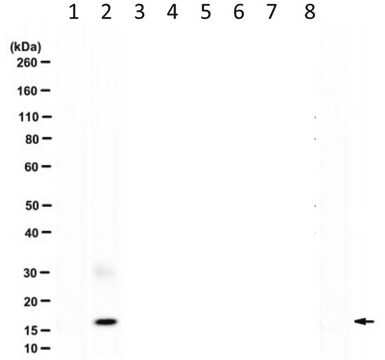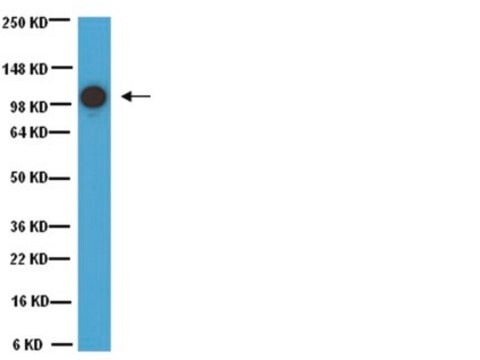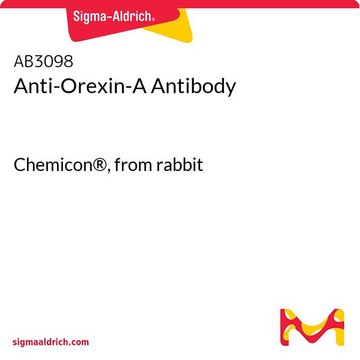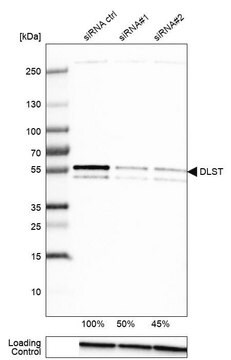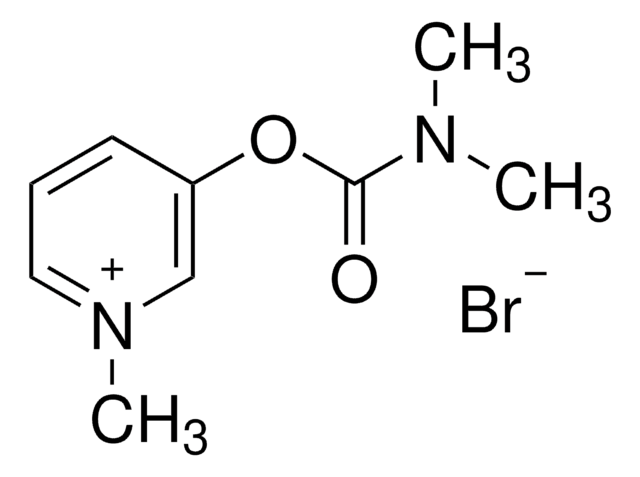MABC1709
Anti-Carcinoma Glycans Antibody, clone mAB-A4
clone mAb-A4, from mouse
Synonym(e):
Cancer Cell Glycans
Anmeldenzur Ansicht organisationsspezifischer und vertraglich vereinbarter Preise
Alle Fotos(1)
About This Item
UNSPSC-Code:
12352203
NACRES:
NA.41
Empfohlene Produkte
Biologische Quelle
mouse
Klon
mAb-A4, monoclonal
Speziesreaktivität
human
Methode(n)
flow cytometry: suitable
immunohistochemistry: suitable
immunoprecipitation (IP): suitable
western blot: suitable
Isotyp
IgMκ
Lagertemp.
2-8°C
Posttranslationale Modifikation Target
unmodified
Allgemeine Beschreibung
Cancer cells contain distinctive glycan structures on their cell surface and their presence on glycoproteins or glycolipids can play a functional role in cancer progression. They are also important targets for cancer therapy. They can be targeted by monoclonal antibodies for detection and intervention. Clone mAb-A4 is shown to specifically bind only to glycans in breast, ovary, testis, lung, pancreas, bone and small intestine cancer cells, but not to benign cells in these tissues. Hence, it can be a useful tool to distinguish between malignant and benign cells. This antibody targets primarily N-linked glycans and bind to H-type I antigen (Fuc-alpha1,2-Gal-beta1,3-GlcNAc), with secondary binding to type I LacNAc. Removal of N-glycans, but not sialic acid, from the antigen using PNGaseF is shown to abolish the binding of this antibody. These antigens are also found to be pluripotency-associated antigens on human embryonic stem cells (hESC). This clone is shown to have a direct cytotoxic effect against hESC and SKOV3 ovarian cancer cells and cause significant reduction in their viability. (Ref.: Liau, B., et al. (2017). Sci. Rep. 7; 14489; Choo, M., et al. (2017). J. Biol. Chem. 292(15); 6163-6176).
Spezifität
Clone mAb-A4 detects ovarian and breast cancer cells and targets H Type 1 glycans.
Immunogen
Live HES-3 human embryonic stem cells.
Anwendung
Immunoprecipitation Analysis: A representative lot immunoprecipitated Carcinoma Glycans in Immunoprecipitation applications (Choo, M., et. al. (2017). J Biol Chem. 292(15):6163-6176).Immunohistochemistry Analysis: A representative lot detected Carcinoma Glycans in Immunohistochemistry applications (Choo, M., et. al. (2017). J Biol Chem. 292(15):6163-6176).Flow Cytometry Analysis: A representative lot detected Carcinoma Glycans in Flow Cytometry applications (Liau, B., et. al. (2017). Sci Rep. 7(1):14489; Choo, M., et. al. (2017). J Biol Chem. 292(15):6163-6176).Western Blotting Analysis: A representative lot detected Carcinoma Glycans in Western Blotting applications (Liau, B., et. al. (2017). Sci Rep. 7(1):14489; Choo, M., et. al. (2017). J Biol Chem. 292(15):6163-6176).
Qualität
Evaluated by Flow Cytometry in BT-474 human breast carcinoma cells.Flow Cytometry Analysis: 1 µg of this antibody detected Carcinoma Glycans in one million BT-474 human breast carcinoma cells.
Physikalische Form
Purified mouse monoclonal antibody IgM in buffer containing 0.1 M Tris-Glycine (pH 7.4), 150 mM NaCl with 0.05% sodium azide.
Format: Purified
Purification Method: Protein G purified
Format: Purified
Purification Method: Protein G purified
Lagerung und Haltbarkeit
Stable for 1 year at 2-8°C from date of receipt.
Sonstige Hinweise
Concentration: Please refer to lot specific datasheet.
Haftungsausschluss
Unless otherwise stated in our catalog or other company documentation accompanying the product(s), our products are intended for research use only and are not to be used for any other purpose, which includes but is not limited to, unauthorized commercial uses, in vitro diagnostic uses, ex vivo or in vivo therapeutic uses or any type of consumption or application to humans or animals.
Analysenzertifikate (COA)
Suchen Sie nach Analysenzertifikate (COA), indem Sie die Lot-/Chargennummer des Produkts eingeben. Lot- und Chargennummern sind auf dem Produktetikett hinter den Wörtern ‘Lot’ oder ‘Batch’ (Lot oder Charge) zu finden.
Besitzen Sie dieses Produkt bereits?
In der Dokumentenbibliothek finden Sie die Dokumentation zu den Produkten, die Sie kürzlich erworben haben.
Unser Team von Wissenschaftlern verfügt über Erfahrung in allen Forschungsbereichen einschließlich Life Science, Materialwissenschaften, chemischer Synthese, Chromatographie, Analytik und vielen mehr..
Setzen Sie sich mit dem technischen Dienst in Verbindung.